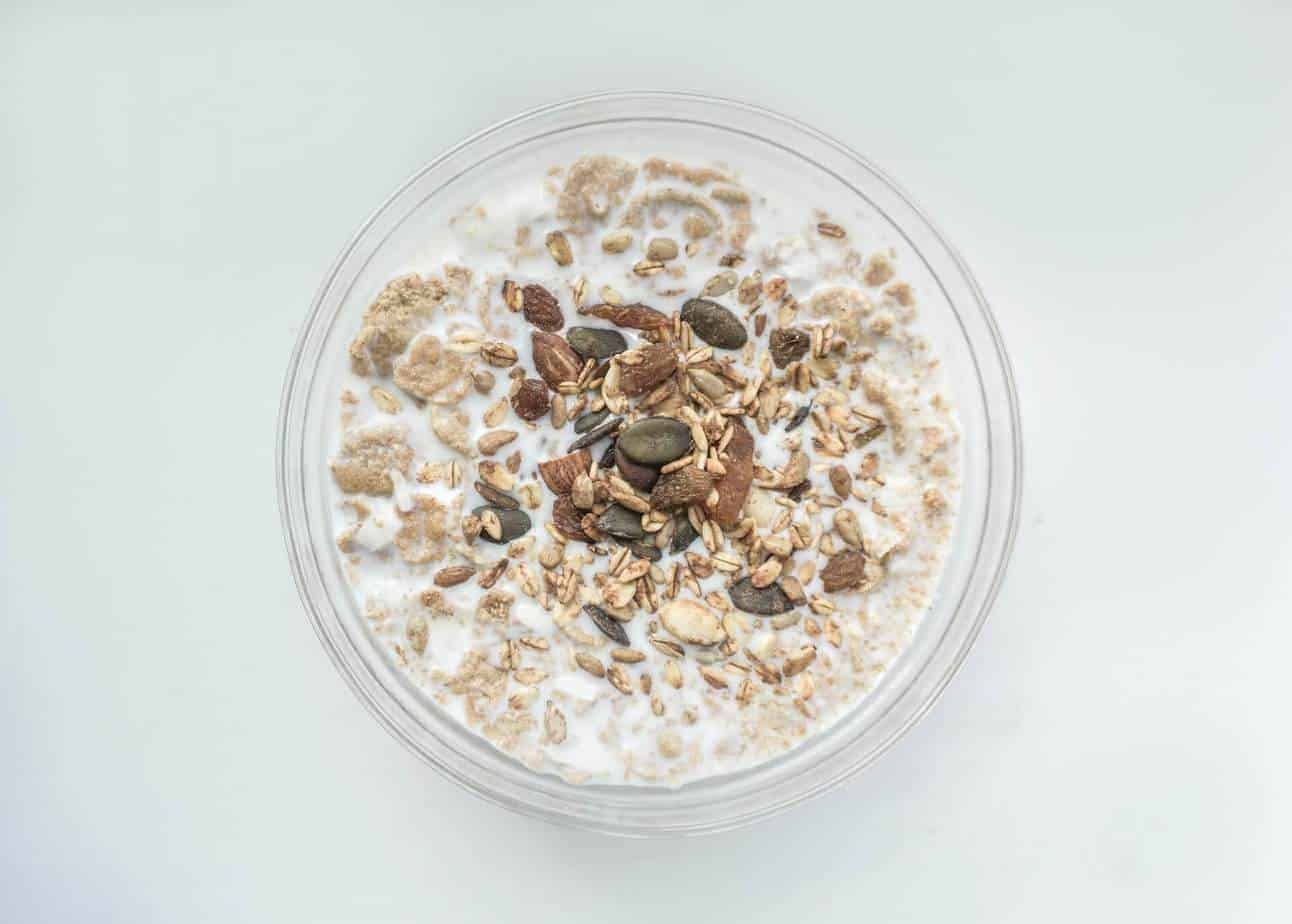


Find foods you can eat.
A Dietitian’s Guide to Alternative Milks
Published on November 5, 2021Whether you’re dairy-free or simply prefer milk alternatives, navigating the milk alternative aisle can be confusing and overwhelming. From almond milk to oat milk, soy milk, pea milk, and more, there is certainly no shortage of dairy-free options. But not all milk alternatives are created equally. As a registered dietitian, I’m here to help walk you through the pros and cons of each milk alternative and provide tips on selecting the best option for you based on your nutrition needs, dietary restrictions, and health goals.
What are milk alternatives?
Milk alternatives are beverages made from nuts, seeds, grains, or legumes by soaking them in water, blending them with water, and then filtering out the solids. The end product has a milky-white color just like dairy milk, and can be used for anything from your morning coffee, to cereal, smoothies, cooking, baking, drinking on its own, and more. Depending on the brand and variety, milk alternatives may be fortified with vitamins and minerals found in dairy milk such as calcium, vitamin D, and vitamin A. Some may contain other additives such as flavorings, sugar, stabilizers, and thickeners.
Who should choose a milk alternative?
While it’s not necessary to incorporate milk alternatives (or dairy milk) into your diet in order to have a nutritionally complete diet, if you’re avoiding dairy milk, it’s nice to have some alternative options, especially if you’re having trouble obtaining nutrients like calcium through your diet.
Someone may choose a milk alternative for a variety of reasons such as a lactose or milk protein intolerance or a milk allergy. Others may opt for milk alternatives due to personal preference, such as those following a vegan diet, as well as individuals with ethical and environmental concerns regarding livestock agriculture practices. Those following a kosher diet avoid dairy products at meals where they’re eating meat, in abidance by traditional kosher dietary law. Lastly, some individuals simply prefer the taste of milk alternatives, or are looking for a lower-calorie option to aid in weight management.
General tips for selecting milk alternatives:
Take nutrient profile into consideration
Depending on your dietary restrictions, nutrition needs, and health goals, you’ll want to focus on different nutritional aspects of milk alternatives. For example, some may want to select a milk alternative with a nutrient profile most similar to cow’s milk in order to help meet their calcium, vitamin D, vitamin A, and protein needs. Others may obtain enough of these nutrients through other dietary sources, but are looking to manage their blood sugar or lose weight, therefore they’ll want to select the option lowest in carbohydrates or calories. Those with certain dietary restrictions such as a soy or nut allergy may need to focus on a specific milk alternative that they do not react to. Regardless of your dietary needs, it’s important to get into the habit of reading food labels so that you can make the best choice for you.
Choose unsweetened options
Many milk alternatives contain unnecessary added sugars that can quickly add up, particularly flavored varieties. For overall health, it’s best to select unsweetened milk alternatives and check nutrition labels for grams of added sugar. If you’re just adding a splash to your morning coffee, a little added sugar won’t make or break your health. However, if you’re using larger quantities of milk alternatives, like in smoothies, it’s best to choose an unsweetened option.
Watch out for potential allergens or additives that you’re avoiding
If you have food allergies, it’s very important to always check the label of your milk alternative for allergen warnings and to review the ingredient list. If you’re allergic to soy and select an almond milk, for example, it’s still possible that the almond milk contains soy-derived ingredients.
Some food manufacturers may also disclose whether or not their product may be subject to cross-contamination if it’s produced in a facility that also handles any of the 8 (soon to be 9) major food allergens—milk, eggs, fish, shellfish, tree nuts, wheat, peanuts, and soy (and soon to be sesame).
Fig’s mobile app can help you to identify milk alternatives that are suitable for your dietary restrictions.
Now that you know what to look for when shopping for milk alternatives, let’s break down the pros and cons of some popular options.
Explaining The Different Types of Alternative Milks
Soy milk
Soy milk has a nutrition profile most similar to cow’s milk, making it a nutrient-dense option. It contains around 7 grams of protein and 12 grams of carbohydrates per cup just like regular milk, and many brands are fortified with calcium. Soy milk is not always fortified with vitamin D, however, and since vitamin D aids in calcium absorption, selecting a brand that contains both is ideal to promote optimal bone health. Unlike cow’s milk, soy milk offers around 2 grams of fiber per cup as a bonus. Since soy is one of the most common genetically modified crops in the U.S., it’s best to choose organic soy milk whenever possible in order to minimize pesticide exposure.
Additionally, it’s not uncommon for those with a milk allergy to also have a soy allergy, particularly among children, so if you’re allergic to milk protein, soy milk may not be a suitable option for you. As always, it’s best to check with your doctor or allergist if you have any concerns about potential allergic reactions.
Pea milk
Pea milk is usually made from a combination of pea protein, water, sunflower oil, stabilizers, and added nutrients like vitamins, minerals, and sometimes omega-3 fatty acids. Pea milk also has a protein content comparable to that of cow’s milk, with around 8 grams of protein per cup, and contains roughly the same amount of fat as a glass of 2% cow’s milk. Some common pea milk brands also contain 100% of the daily value for vitamin B12, around 240 IU of vitamin D, and 440 mg of calcium per cup thanks to fortification. Pea milk is lower in carbohydrates than soy milk or cow’s milk, with less than 1 gram per cup, making it a good choice for diabetics or those looking to manage their weight.
Flaxseed milk
Flaxseed milk is relatively new to the alternative milk market and has garnered attention for its high omega-3 fatty acid content, a beneficial essential fatty acid with anti-inflammatory properties. Some flaxseed milks are fortified with pea protein, providing a substantial 8 grams of protein per cup. Some varieties also contain added calcium, vitamin D, vitamin A, and vitamin B12, but not all flaxseed milks are fortified. If flaxseed milk isn’t fortified, then it will be relatively low in protein (about 3 grams per cup), low in calcium, and won’t contain vitamin A or vitamin D. This is not necessarily a bad thing, just something to take into consideration if those nutrients are a concern for you. Fortified or not, flaxseed milk is low in carbohydrates and relatively low in fat, with just 2-3 grams of fat per cup, making it an appealing choice for those looking for a low calorie option. Some flaxseed milks also contain 2-3 grams of gut health-promoting fiber per cup, plus flaxseeds contain lignans, which are compounds with antioxidant effects.
Hemp milk
Hemp milk comes from shelled hemp seeds, also referred to as “hemp hearts,” and has a slightly nutty flavor. Similar to flaxseed milk, hemp milk is rich in omega-3 fatty acids, therefore it can be a way for those avoiding seafood to obtain omega-3s from alternative sources. Hemp milk contains around 3 grams of protein per cup, 4-5 grams of fat per cup, and is very low in carbohydrates, usually containing 0 grams per cup, unless sweetened. Hemp milks may or may not be fortified with calcium or other vitamins and minerals, but hemp seeds are naturally high in iron. In fact, some varieties contain as much as 15% of the RDA for iron per cup, so if iron-deficiency is a concern for you, hemp milk is a great option.
Oat milk
Oat milk has quickly become one of the most popular milk alternatives around due to its rich, creamy consistency and high environmental sustainability rating. That being said, not all oat milks are created equally and there are a few nutritional considerations to keep in mind.
Since it’s made from a grain, oat milk is significantly higher in carbohydrates and naturally occurring sugars compared to milk alternatives made from nuts, seeds, and legumes, with 15-20 grams of carbohydrates per cup. It is slightly higher in protein than some other milk alternatives, with around 2-4 grams per cup, however, this is still less than the amount in cow’s milk. Fat content of oat milk can greatly vary depending on the brand, but it typically ranges from 2.5-9 grams per cup. Many popular brands contain at least 5 grams of fat per cup, making oat milk a higher fat option. The fat in oat milk usually comes from oils such as sunflower oil or canola oil. While these oils are fine to consume in moderation, if you’re having them frequently in large quantities, you may want to find alternatives. These oils are high in omega-6 fatty acids and consuming too many omega-6s can promote inflammation. Since omega-6 fatty acids are very prevalent across our food supply, most of us already get plenty, but lack sufficient omega-3 fatty acids, which oppose inflammatory processes in the body. These seed oils also go through a more extensive extraction process compared to other oils (like olive oil), therefore they tend to be heavily processed. Lastly, for those concerned with weight management, oat milk is generally higher in calories compared to other milk alternatives.
On the positive front, oat milk is frequently fortified with calcium, vitamin D, vitamin B12, and vitamin A, helping you to meet your nutrient needs. It’s also higher in fiber than other milk alternatives. More specifically, oat milk contains beta-glucans, a type of prebiotic fiber that feeds our good gut bacteria and offers a variety of health benefits. Lastly, you may want to consider selecting an organic oat milk, as conventional oats are commonly sprayed with the pesticide glyphosate.
Rice milk
Since rice allergies are relatively uncommon, rice milk is one of the least allergenic milk alternatives available and can be a nice option for those with multiple food allergies. That being said, from a nutritional standpoint, rice milk is very low in protein, vitamins, and minerals, and not all brands are fortified. Rice milk is highest in carbohydrates, with around 20-25 grams of carbs per cup, so it may not be the best choice for diabetics. Similar to oat milk, the fat in rice milk comes from seed oils like canola, safflower, and sunflower, however, rice milk contains less fat than oat milk, with around 2 grams per cup. Since rice accumulates higher levels of arsenic from soil compared to other foods, it’s best to avoid heavily relying on rice products, particularly for young children and pregnant women. So if you’re eating cream of rice for breakfast, rice cakes with lunch, and rice-based pasta at dinner, you may want to select a different milk alternative.
Coconut milk
Coconut milk is available in cans as well as in cartons or bottles. The canned versions are typically used for cooking, such as for making curries. Canned coconut milks are highest in fat, with 20-30 grams of fat per cup.
The coconut milks found in cartons and bottles are used just like any other milk alternative and have a fat content comparable to that of 2% cow’s milk, making them a slightly higher fat option compared to milk alternatives like almond or rice milk. Out of all the milk alternatives, coconut milks are lowest in protein, with many brands containing as little as 0 grams per cup. They’re also low in carbohydrates with only around 1 gram per cup for unsweetened varieties. They may or may not be fortified with nutrients found in cow’s milk, such as calcium, vitamin D, or vitamin A, so if that’s a concern for you, it’s important to check the label.
Almond, cashew, and macadamia milk
Nut-based milks like almond, cashew, and macadamia milk have similar nutrition profiles. Almond, cashew, and macadamia milks all happen to be rich in vitamin E, an antioxidant that’s beneficial for eye and skin health. There are 2 main varieties of nut milks available, one being those with very minimal ingredient lists (like nuts, water, and salt), sometimes referred to as “homestyle” or “homemade style” nut milks. These usually aren’t fortified with vitamins or minerals and are fairly low in protein, but much higher in fat compared to other nut milks. They contain 7-12 grams of fat per cup, giving them a thick, creamy texture. They are so minimally processed that you could make a similar version yourself with a blender and strainer. These are a good option for those avoiding additives such as stabilizers and gums, however, if you’re looking for a milk alternative that will provide protein, calcium, or vitamin D, these aren’t your best bet.
In contrast, there are nut milk varieties with lengthier ingredient lists, sometimes including undesirable additives like stabilizers and gums. These nut milks are usually fortified with calcium and sometimes other nutrients like vitamin D or vitamin B12. In fact, many brands contain 50% more calcium than dairy milk thanks to fortification. They’re low in fat, carbohydrates, protein, and calories, with most brands averaging between 30 and 60 calories per cup. These are nice options for those looking to lose weight, as well as those trying to boost their calcium intake, but if you’re looking for a protein-rich option, they aren’t ideal. Additionally, some brands contain a dietary emulsifier called carrageenan, which has been associated with intestinal inflammation in mouse studies, so be sure to check ingredient lists before purchasing.
Summary
When it comes to selecting a milk alternative, there is no right or wrong and every option has it’s advantages and disadvantages. To make the best choice for you, it’s important to take your unique nutritional needs and restrictions into account and review food labels carefully.
You can also use the Fig app to find alternative milks that fit all of your dietary needs.
 Q&A with Dietitian
Q&A with Dietitian How to Incorporate More Fiber into Your Diet
How to Incorporate More Fiber into Your Diet